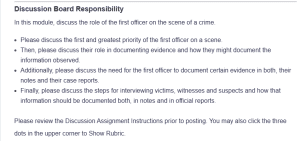Discussion Board Responsibility
Please discuss the first and greatest priority of the first officer on a scene.
The first and most crucial condition for the first officer on a scene is ensuring safety. This includes evaluating and mitigating threats to themselves, victims, and other eyewitnesses. The officer must assess the potential threats in handling suspicious individuals with weapons or other unsafe circumstances within the environment and contain them (Morris & Merson, 2017). This step is important because subsequent investigative activities would be less efficient without properly setting up a secure and manageable environment.
Then, please discuss their role in documenting evidence and how they might document the information observed.
The first officer takes charge of this function, which involves taking observations and notes of the crime scene when they first get to a scene. This includes noting the scene’s condition, capturing the layout and certain pieces of evidence through photography, and drawing layouts to portray spatial relations (Morris & Merson, 2017). Documentation is critical as it retains the scene’s original state and offers a clear statement of the findings that will be viable at other intervals when the case is again pulled to different investigations or even in court.
Additionally, please discuss the need for the first officer to document certain evidence in both, their notes and their case reports.
Taking notes and case reports is crucial for properly documenting a crime scene and investigative procedures. Notes taken at the scene capture immediate observations and details that might be forgotten. These notes are then used to prepare comprehensive sub-sectioned case reports that objectively document the information for legal or investigative work (Morris & Merson, 2017). Therefore, such documentation must contain all the necessary information stored in both formatting types—this increases reliability and allows seamless cooperation between police and judicial bodies.
Finally, please discuss the steps for interviewing victims, witnesses and suspects and how that information should be documented both, in notes and in official reports.
Interviewing victims, witnesses, and suspects involves systematically conducting interviews to acquire reality-based information. First, the officer should develop a positive relationship or a rapport with the person; the next step would be making general and open-ended questions about the event or interaction. The officer must pay attention to the communicated details, take written notes and ask additional questions if necessary (Horsman, 2021). This makes communication accurate and complete since one can read the notes to the interviewee. Such an approach proves helpful in checking the data and acknowledging the discrepancies, which are vital for the reconstruction of the events for purposes of investigation and trial.
References
Horsman, G. (2021). The collectors ranking scale for ‘at‐scene’digital device triage. Journal of Forensic Sciences, 66(1), 179-189.
Morris, K., & Merson, M. (2017). Report writing for law enforcement and correction professionals. Prentice Hall.
ORDER A PLAGIARISM-FREE PAPER HERE
We’ll write everything from scratch
Question 
Discussion Board Responsibility
In this module, discuss the role of the first officer on the scene of a crime.

Discussion Board Responsibility
- Please discuss the first and greatest priority of the first officer on a scene.
- Then, please discuss their role in documenting evidence and how they might document the information observed.
- Additionally, please discuss the need for the first officer to document certain evidence in both, their notes and their case reports.
- Finally, please discuss the steps for interviewing victims, witnesses and suspects and how that information should be documented both, in notes and in official reports.
Please review the Discussion Assignment Instructions prior to posting. You may also click the three dots in the upper corner to Show Rubric.
- Report Writing for Law Enforce
ment and Corrections Professio nals
